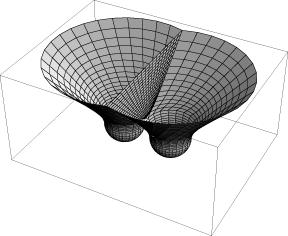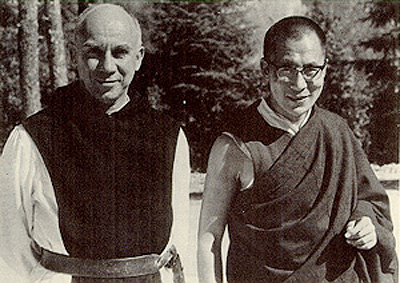The most important symbols of all are those that help us define reality. These symbols are primarily the purview of physics and religion. In physics, these symbols are, fundamentally, in the language of mathematics, which allows one to describe the indescribable with a degree of precision unattainable in ordinary language. (As Richard Feynman did.) Religion uses ordinary language in an extraordinary way do the same kind of thing. (Thomas Merton being the best at it in the 20th Century.)
For centuries, going back to at least Galileo, science and religion were unable to speak to each other. Science focused on the world of matter and religion on matters of the spirit. They did overlap somewhat in the soft science of psychology, as far as psychology is the study of consciousness. If thi s confluence were mapped as the conjoined area in a Venn Diagram, I’d put Freud in the scientific circle and Jung in the spiritual circle.
s confluence were mapped as the conjoined area in a Venn Diagram, I’d put Freud in the scientific circle and Jung in the spiritual circle.
Today, there is considerable overlap between religion and the hardest of sciences, physics. It happened because of quantum mechanics, where things get weird pretty quickly: matter and energy are the same thing… time is relative… the existence of parallel universes is quite likely… there may be as many as 11 dimensions… and, as was demonstrated in the famous “double slit experiment,” light is both a particle and a wave, depending on how we observe it. Because of experiments on the dual nature of light, quantum physicists arrived at the inconvenient truth that there is an unavoidable connection between the observer and the observed, which implies that matter/energy has consciousness, that it is somehow aware of us and that we can change the state of matter or the level of energy by simply thinking about it. (Which by extension, also means praying about it. See transubstantiation.)
What all of this might mean – at least to a mathematical illiterate like me – is that religion and physics are pursuing the same path by different means. Both are attempting to tap into and, ultimately, to manipulate ultimate reality. And I am not alone. Pope Pius XII said much the same in his 1951 Address to the Pontifical Academy of Sciences. Respected physicists like Frank Tipler and Paul Davis are inching toward a similar belief. (Actually, Tipler has moved beyond inching. His latest book is The Physics of Christianity.)
 Perhaps this is good time to define my idea of ultimate reality, which is nothing more or less than Plato’s Allegory of the Cave. That is, reality is the light that casts the shadows that most of us mistake for reality. We can experience reality only by unshackling ourselves from conventions of perception and turning to see what is really there. Plato used the term “form” to describe what is really there. For example, there exists the form for a chair, which is what a chair really is. The thing we sit in at our dinner table is a shadow of this form, and it is as much as we can experience of a chair with our five senses. The source of reality in Plato’s allegory is the sun, which is the ultimate source of the light that illuminates the forms that cast the shadows we see. (And if someone managed to free himself from the world of shadows and turned to see the forms and the sun behind them, he would be truly “enlightened.” However, if he returns to the cave and attempts to free others from their addiction to shadows they would consider him crazy, probably dangerous, and would likely kill him. Sound familiar? Platonic ideas heavily influenced Christian theology.)
Perhaps this is good time to define my idea of ultimate reality, which is nothing more or less than Plato’s Allegory of the Cave. That is, reality is the light that casts the shadows that most of us mistake for reality. We can experience reality only by unshackling ourselves from conventions of perception and turning to see what is really there. Plato used the term “form” to describe what is really there. For example, there exists the form for a chair, which is what a chair really is. The thing we sit in at our dinner table is a shadow of this form, and it is as much as we can experience of a chair with our five senses. The source of reality in Plato’s allegory is the sun, which is the ultimate source of the light that illuminates the forms that cast the shadows we see. (And if someone managed to free himself from the world of shadows and turned to see the forms and the sun behind them, he would be truly “enlightened.” However, if he returns to the cave and attempts to free others from their addiction to shadows they would consider him crazy, probably dangerous, and would likely kill him. Sound familiar? Platonic ideas heavily influenced Christian theology.)

M-Theory: The visible universe is a three dimensional object (called a brane, or membrane, thus "M" Theory) embedded in a higher dimensional spacetime (called the bulk)
In the parlance of modern physics, “seeing the the sun” in Plato’s allegory would be finally discovering the Grand Unified Theory, or GUT, which is an explanation of how the four fundamental forces of the universe – gravitation, electromagnetism, strong interaction, weak interaction – work together. Current theories can account for everything but gravity. One idea from M-Theory, the latest and greatest, which calls for 11 dimensions, postulates that gravity can’t be mathematically incorporated in to a GUT because it actually exists in another dimension and only leaks into the dimensions we can perceive. (At least I think that’s what is says. Warped Passages by Lisa Randall is an excellent book on this topic, but at about the 300-page mark I hit a brick wall.)
In The Tao of Physics, physicist Fritjof Capra does a good job of highlighting the ways that physics and religion are taking similar paths in seeking to understand ultimate reality. Eastern religions have long taught that reality exists beyond the world of the senses, that distinctions (such as between matter and energy, or between particle and wave) are more apparent than real, that the knower and the thing known are closely related and that all phenomena are manifestations of a basic oneness. These ideas were also developed by Western Mystics, such as Meister Eckhart, St. John of the Cross and St. Teresa of Avila. (Contrary to the Gospel of Shirley MacLaine, all mystic truths do not come from the East or the Incas.) And the mystery of The Trinity, another Western idea, is a classic example of how reality can appear to be comprised of parts but is actually one.
A key point Capra makes is that in both modern physics and Eastern philosophies, energy is all that exists: What we perceive as matter is just an arrangement of energy. And reality is a network; not a network of things, just a network, and the more in tune we are with this network, the more real we are.
Here’s how my favorite mystic, Thomas Merton, puts it in No Man Is An Island:
“Pride makes us artificial, and humility makes us real.” Focusing on yourself tends to disconnect you from the network of reality. Surrendering to the network, connecting to God, frees you to be an authentic person instead of an artificial and false construct.
“The reason why men are so anxious to see themselves {i.e., to be preoccupied with appearances}, instead of being content to be themselves, is that they do not really believe in their own existence.” Because we only exist to the extent we are connected to the reality of God.
“Sin… destroys the one reality on which our true character, identity, and happiness depend: our fundamental orientation to God.” That is, sin disconnects us from God, the source of reality; it causes us to believe the lie that we are real and God is not; it puts the creature before the creator and thereby cuts us off from creation.
Salvation (and modern physics) is full of contradictions: “We become ourselves by dying to ourselves. We gain only what we give up, and if we give up everything we gain everything. We cannot find ourselves within ourselves, but only in others, yet at the same time before we can go out to others, we must first find ourselves. We must forget ourselves in order to become truly conscious of who we are…. The only effective answer to the problem of salvation must therefore reach out to embrace both extremes of a contradiction at the same time. {Ex: light is both a particle and a wave, energy and matter are the same thing.} Hence that answer must be supernatural. That is why all the answers that are not supernatural are imperfect: for they only embrace one of the contradictory terms, and they can always be denied by the other.”
“The whole function of the life of prayer is to… live God’s law in concrete reality by perfect and continual union with His Will.” And through this communion with God, we come to understand the reality beyond the law (both the laws of morality and the laws of physics), and “become perfectly free… knowing the meaning of St. Paul’s statement that the ‘law is not made for the just man’.”
So, here are two things to ponder about science and religion:
1) Why is is that, thousands of years ago, mystics were able to intuit the same concepts of ultimate reality that modern physicists are now uncovering?
2) Is it possible to understand reality by experimenting with appearances and thinking about the results of these experiments? Or must you actually experience reality, immerse yourself in it so that you become one with it, and thereby transcend the laws that can only approximate reality?

